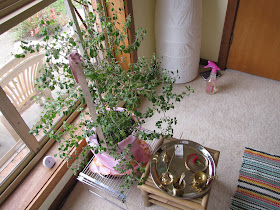This is the most delicate issue in growing Tulsi plants. One that is, in my humble opinion, the most usual reason for having troubles with growing her.
Give her too much water and she will probably get fungi and struggle to survive.
Don't give her enough and she will be dry and struggle to survive.
Give her a lot after not watering her enough for a while and she will get in a state of shock and probably shed some leaves in protest.
How to find balance?
Easy. Make a habit of watering her in small doses each day and each day touch the soil around her stem to learn to feel what is perfect dampness.
In beginning stages of her life she would probably need just a teaspoon of water a day around her roots.
Keep touching the soil each morning. It should be dry on surface with a bit of moisture beneath. The water you give her today should be absorbed by her and the rest evaporated by tomorrow morning leaving the soil dry on surface and slightly damp under the surface.
As she grows taller you should increase the amount given daily while regularly checking the dampness using your fingers.
You will need to be proactive and adjust to the circumstances and make sure she has enough but not too much water.
Another good way to find out if she is thirsty is to touch her leaves. When her leaves are nice and firm she has enough water, when her leaves are soft and droopy she needs more water.
Another thing from my experience is that if you only keep watering her over the top she could be totally dry on the bottom of the pot, especially when she grows bigger and fills the pot with her roots.
So, when she grows a bit bigger you should water her to the point of water runoff about every week in the hot summer weather and about once in two weeks in the winter time and then stop watering for few days until she absorbs some of the water and then continue with small quantity you used to give her. This will give her enough moisture throughout her pot.
When watering her to the point of runoff a good thing to do is to have something that will keep Tulsi's pot above the saucer. That way the excess water would drip down from her pot and the other benefit is the soil will be better aerated making her grow more beautiful.
 |
| Stainless steel grates |
|
|
Before our Tulsi got too big for this purpose I've used stainless steel grates for drying the kitchen utensils that I bought in Aldi.
You can see on the left how this grates looked. Underneath i had just a simple salad bowl that would catch all the excess water and later I would use that water to water other plants as her maha ;)
Another experience I would like to share is that at one point I thought it would be better if I used some device that will tell me the exact soil humidity so I bought a relatively good 'moisture meter' and started reading the moisture in the soil around her but I didn't want to stick the sensor rod in her roots every time I needed to check moisture as this would hurt her so I placed it in the corner of the pot and left it there and it was giving decent results for some time and then it stopped moving from certain reading and it took me a good week or so to realize this and when I took it out it was corroded. Unfortunately it meant I wasn't giving her enough water and when I gave her plenty of water to satisfy her she went into a shock and shed almost half of the leaves and it took me months to get her to that healthy state again. So, if you are thinking about artificial measuring of soil moisture forget about it.
Your finger and your intuition are the best measuring instruments in the universe.
Just have to learn to trust them.
Watering her is your best interaction with her and it is the most rewarding feeling when you learn to water her with good balance. After you do it for some time you will start feeling how much she needs. It's easy, you just need to
believe in yourself and follow your heart.
Here we are, if you've read my posts so far you are ready to grow Tulsi by yourself.
 Here is one of my handy solutions I've tried one of the first few winters after she joined us.
Here is one of my handy solutions I've tried one of the first few winters after she joined us.






